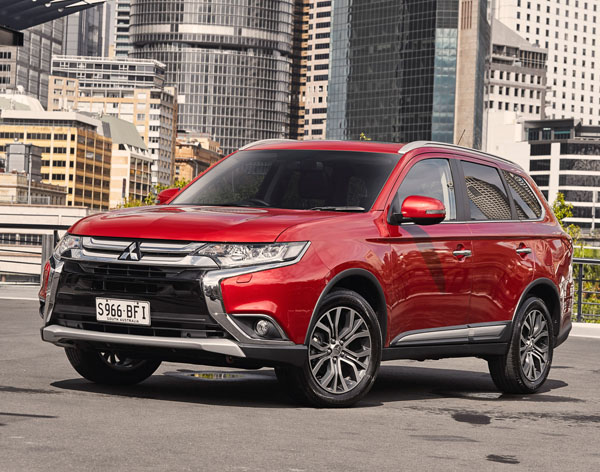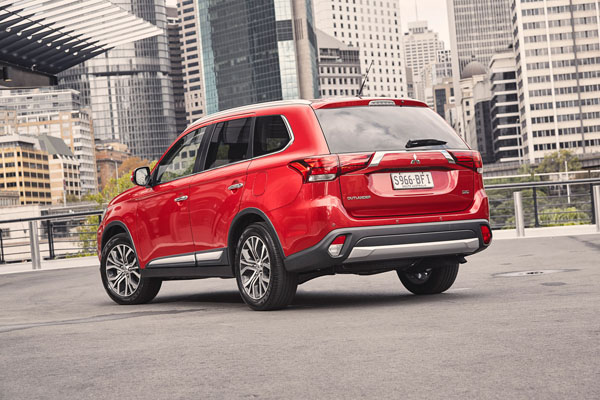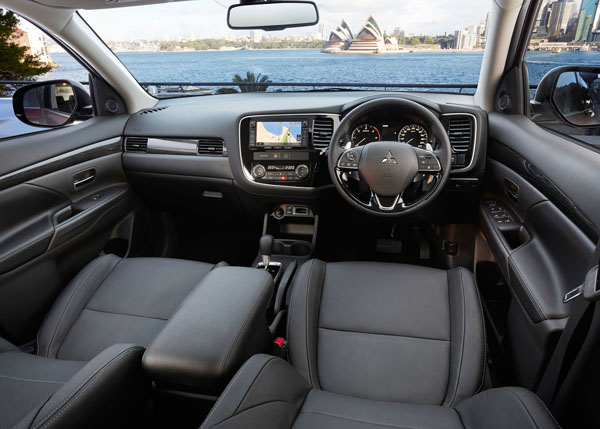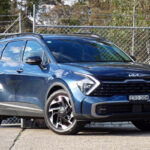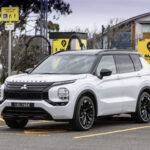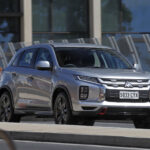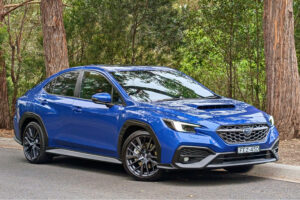Mitsubishi Outlander is an important vehicle for the Japanese giant, competing as it does in one of the strongest market areas in Australia, that of midsize SUVs.
Mitsubishi has long been a major player in the field of comfortable passenger-oriented vehicles, having introduced the Pajero to a surprised public downunder 33 years ago. Back then 4WDs were somewhat crude truck-based vehicles, Mitsubishi showed it didn’t have to be like that.
Outlander first arrived in Australia in 2003 as a smaller brother to Pajero and has sold consistently since the get-go. Our road test this week was of the facelifted and mechanically improved Outlander recently introduced.
STYLING
Big radiator grilles are all the rage at moment and Outlander’s ‘Mitsubishi Dynamic Shield’’ is positively huge, indeed the front is composed almost entirely of grille. Can’t say I’m keen on the look, but the buying public will make the final decision.
Less controversial are silver roof rails, a new design of 18-inch alloy wheels and LED daytime running lights and taillights.
Rear styling sees a new design bumper and silver defuser. The chromed tailgate garnish and LED rear lights work nicely to our eyes.
Inside, the 2016 Outlander has a large display screen, a redesigned steering wheel, new accent colours and materials, and better seat bolstering. Mitsubishi Australia says the interior is aimed at giving a prestige appearance and we feel they have made this work.
MODELS
The latest Mitsubishi Outlander comes in three model variants: LS, GLS and top-spec Exceed. Our test vehicle was the Exceed.
ENGINE / TRANSMISSION
Mitsubishi Outlander’s complex powertrain options continues as in the 2015 model. You can buy a 2.0-litre petrol with a five-speed manual (LS model only) or continuously variable transmission (LS and XLS); a 2.4-litre petrol, only with a CVT (all models), or a 2.2-litre turbo-diesel with a six-speed torque convertor auto (only offered in the Exceed).
Two-wheel-drive (the front wheels) or all-wheel drive transmissions are offered and you can choose an Outlander with five or seven seats.
Our test Outlander Exceed had the 2.4 petrol, all-wheel drive and seven seats.
SAFETY
The 2016 Outlander range continues to have five-star ANCAP safety rating. It has front, side, curtain and knee airbags.
Traction control and active stability control (ASC), ABS with electronic brake distribution (EBD) help to keep it out of trouble in the first place.
The Exceed we tested had additional safety features, in adaptive cruise control and forward collision mitigation.
DRIVING
We found the seats more compliant than the outgoing Outlander – you now sit in the seats, not on them, yet they still have plenty of support.
The interior is also quieter with engineers telling us they have made 39 improvements to NVH (noise, vibration, harshness) components and increased body rigidity.
On coarse-chip surfaces noise intrusion is minimal. Contributing to the overall noise reduction is extensive use of sound insulation and isolation damping materials as well as a redesign of the engine air intake system. Other changes include noise insulating windscreen glass, better weather stripping, different tyres and modified suspension mounts as well as tuning to the dampers.
We did feel the wind noise generated by the large door mirrors was a bit much at times. Then again, the mirrors provide a good field of view and certainly eliminate blind spots when correctly adjusted.
The engine has enough power, but only just enough at times, with a load on board and hills under its wheels there are times you feel that more grunt would be nice.
Fuel consumption during our test period was impressively low, in the high sixes and low sevens, on motorway trips, but rose sharply to 10 to 12 litres per hundred kilometres around town.
Modifications to the CVT make it more acceptable to driving enthusiasts as there’s less of the ‘slipping clutch’ feel than previously. The transmission also has manual overrides if you feel the computer is getting its ratio choices wrong.
The transmission is slow to get the Outlander off the line from a standstill, embarrassingly so at times.
Outlander is no sports SUV but it clings on nicely on twisty roads, albeit without it feeling really happy at being hustled along. Drive it the way it’s supposed to be driven, as a sensible family driver would, and it’s fine.
SUMMING UP
Mitsubishi’s recently revised Outlander continues the company’s tradition of high build quality and a semi-prestige feel. The latest changes significantly improve interior comfort and this SUV can be used on extended trips in the Australian countryside in a manner that will leave all occupants comfortable and relaxed when they dismount.
AT A GLANCE
MODEL RANGE
LS 2.0-litre petrol 2WD five-seat five-door wagon: $28,490 (manual), $30,490 (CVT)
XLS 2.0-litre petrol 2WD five-seat five-door wagon: $33,490 (CVT)
LS 2.4-litre petrol 4WD five-seat five-door wagon: $33,490 (CVT)
XLS 2.4-litre petrol 4WD seven-seat five-door wagon: $36,490 (CVT)
Exceed 2.4-litre petrol 4WD seven-seat five-door wagon: $43,490 (CVT)
XLS 2.2-litre turbo-diesel 4WD seven-seat five-door wagon: $39,490 (automatic)
Exceed 2.2-litre turbo-diesel 4WD seven-seat five-door wagon: $46,490 (automatic)
Note: These prices do not include dealer or government charges. Contact your local Mitsubishi dealer for drive-away prices.
FEATURES
ABS Brakes: Standard in all models
Cruise Control: Standard in all models
Dual Front Airbags: Standard in all models
Front Side Airbags: Standard in all models
Curtain Airbags: Standard in all models
Electronic Stability Program: Standard in all models
Rear Parking Sensors: Standard in all models
Reversing Camera: Standard in all models
USB/Auxiliary Audio inputs: Standard in all models
Bluetooth: Standard in all models
SPECIFICATIONS (Mitsubishi Outlander Exceed 2.4-litre petrol five-door wagon)
ENGINE:
Engine Capacity: 2.360 litres
Configuration: Four cylinders in line
Maximum Power: 124 kW @ 6000 rpm
Maximum Torque: 220 Nm @ 4200 rpm
Fuel Type: Petrol 91RON
Combined Fuel Cycle (ADR 81/02): 7.5 L/100km
CO2 Emissions: 174 grams per kilometre
Greenhouse Vehicle Guide Rating: 7.0/10
Air Pollution Rating: 7.5/10
DRIVELINE:
Continuously variable. All-wheel drive.
DIMENSIONS, WEIGHT AND CAPACITIES:
Length: 4655 mm
Wheelbase: 2670 mm
Width: 1800 mm
Height: 1680 mm
Turning Circle: 10.6 metres
Kerb Mass: 1535 kg
BRAKES:
Front: Ventilated disc.
Rear: Solid disc
CAPPED PRICE SERVICING
Four years – every 15,000 km or 12 months
STANDARD WARRANTY:
Five years/100,000 km




